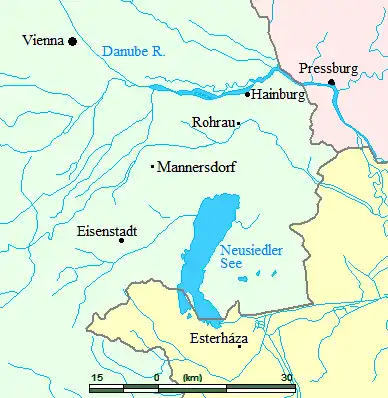
Map of Haydn's principal residences
This article is a chronologically-ordered list of the locations where the composer Joseph Haydn lived.
Haydn, who lived from 1732 to 1809, spent most of his life in a small region near Vienna no more than about 50 km. across, shown on the map at the right. This region was politically part of the Habsburg Empire; for reference the map shows the boundaries of modern-day Austria (green), Hungary (yellow), and Slovakia (pink).
Chronological list
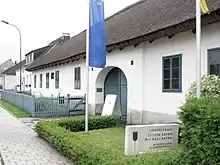
Haydn's birth home in Rohrau
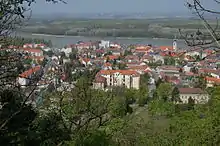
Hainburg
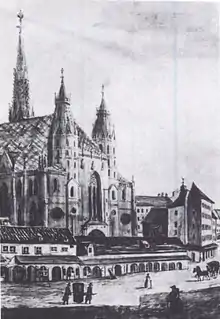
Foreground: the Kapellhaus of St. Stephen's Cathedral (demolished 1804)
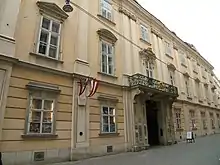
The city palace of the Esterházy family, on the Wallnerstrasse in Vienna
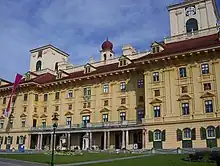
Schloss Esterházy in Eisenstadt, the seat of the Esterházy family
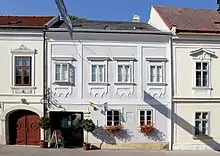
The house Haydn owned in Eisenstadt

Esterháza Palace in Fertőd, Hungary

The Hanover Square Rooms, principal venue of Haydn's performances in London
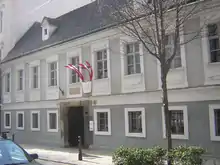
Haydn's house in Mariahilf, Vienna
— he lived here in his last years (1797–1809); the address is Haydngasse 19
— he lived here in his last years (1797–1809); the address is Haydngasse 19
The approximate dates in each location are as follows.[1]
- 1732–1737: the tiny village of Rohrau. Haydn's early-childhood home, at Obere Hauptstrasse 25, has been restored many times since Haydn's day and is currently a Haydn museum.[2]
- 1737–1739 or 1740: the small town of Hainburg, in the home of his distant relative, the schoolmaster and choral director Johann Mathias Franck, who gave him his first formal training as a musician.
- 1740-ca. 1757: Vienna, as follows:
- 1740-November (?) 1749: the Kapellhaus, quarters for choirboys at St. Stephen’s Cathedral.[3] Haydn sang under the direction of Georg Reutter and continued his musical training.
- November 1749-Spring/Summer 1750: Following the loss of his soprano voice (hence dismissal from St. Stephens) Haydn shared crowded lodgings with the family of Johann Michael Spangler, a professional singer at the St. Michael's church who had participated in performances with Haydn.
- 1750- various locations in Vienna, starting out with an unheated garret room in the Michaelerhaus, attached to the Michaelerkirche.
- Journeys during this period:
- Shortly after ending his service as a chorister, Haydn made a pilgrimage to Mariazell.[4]
- Summer 1753: Spent in the spa town of Mannersdorf, in company with his employer and teacher Nicola Porpora. Haydn served Porpora as accompanist and valet; Porpora in turn was serving the mistress of the Venetian ambassador Correr; she was visiting the spa for the summer. At parties hosted by Prince Hildburghausen, Haydn met a number of eminent composers also visiting the spa: Gluck, Wagenseil and Bonno[5]
- 1757–1761: In the employ of Count Morzin. Winters in Vienna, summers at the Count's estate in Dolní Lukavice, often referred to as Lukavec, now in the Czech Republic. For details, including the unclarity of the dates given, see Count Morzin.
- 1761–1766: Vice-Kapellmeister to the Esterházys. In these early years, the Esterházy court spent some of the time in its palace on the Wallnerstrasse in Vienna, some of the time in the family's ancestral seat, Schloss Esterházy, in the small town of Eisenstadt about 40 km. away. Haydn bought a house in Eisenstadt (shown) in 1766, on his promotion to full Kapellmeister.
- 1766–1790: the Esterházy court gradually shifted its time away from the old Vienna-Eisenstadt arrangement to a system involving the new palace at Esterháza, built starting in the 1760s at Fertőd in modern-day Hungary, about 40 km. from Eisenstadt. Initially, Esterháza was visited only during the summer; by 1778 this had expanded to ten months per year; and Haydn sold his house in Eisenstadt.[6] At Esterháza Haydn lived in a house in the grounds of the palace (at Madach sétány 1, now a music museum (Muzsikaház) and gallery).
- Journeys during this period:
- In the late 1760s the Esterházy court made various journeys to their palaces in Pressburg (modern-day Bratislava) and at Kittsee, just across the Danube from Pressburg.[7]
- In the mid-1770s Haydn performed with his orchestra at the palace the Esterházys maintained near Pressburg (today called Bratislava and capital of Slovakia).[8]
- Journeys during this period:
- 1790, approx. October–December: following the death of his patron Nikolaus Esterházy on September 28, Haydn settled in Vienna, renting rooms from his friend Johann Nepomuk Hamberger, who was an official in the Lower Austrian government.[9] The address was Wasserkunstbastei no. 1196 (first numbering); entrance on Seilerstätte no. 21. Mrs. Haydn continued to rent rooms from Hamberger during Haydn's absence in London.[10] The building was later inhabited by Beethoven (1801) and was rebuilt in 1805.[11]
- January 1791 – June 1792: London. The city is 1237 km. from Vienna , and thus vastly farther than any other location where Haydn lived.
- January–May 1791: #18, Great Pulteney Street, a lodging house where Haydn's host and collaborator Johann Peter Salomon also lived. Haydn did his work in a room provided him by the Broadwood piano firm, across the way at #33.[12]
- May–July 1791. Seeking quiet in which to compose,[13] Haydn moved to a farm in the then rural district of Lisson Grove. Haydn left when the farm was sold in July.[14]
- August–September 1791. In the country at the home of the banker Nathanael Brassey. From historical records Scott deduces that this was called Roxford, in the village of Hertingfordbury, 21 miles to the north of London in Hertfordshire. Unlike any of the other places where Haydn lived while in England, this home is still standing.
- Late September 1791. Probably back at #18, Great Pulteney Street.[15]
- Journeys during this period:
- July 1791: Oxford, where he was awarded an honorary doctorate by the University in a grand ceremony.[16]
- End of November 1791: Haydn also visited Cambridge, on his way to the home of Patrick Blake in Langham, Suffolk[17]
- 14 June 1792: Windsor Castle, then Ascot for the races. The following day to Slough (visit to astronomer/musician William Herschel).[18]
- July 1792 – January 1794: rented lodgings in Vienna
- February 1794 – August 1795: London, #1, Bury Street St. James.
- Journeys during this period:
- Starting 9 July 1794: Hampton Court, Gosport, Portsmouth, the Isle of Wight, and Winchester[19]
- Early August, 1794: Bath and Bristol, .[20]
- 26 August 1794: on a visit to Sir Charles Rich in Farnham, the ruins of Waverley Abbey[21]
- Journeys during this period:
- September 1795 – May 1809: Vienna, as follows
- September 1795 – 1797: lodgings on the Neuer Markt in the old city
- 1797–1809: a house Haydn purchased in Windmühle, then a suburb of Vienna, nowadays part of the city's 6th Bezirk, Mariahilf. The address was then Steingasse 73, today it is Haydngasse 19; the house serves as a Haydn museum.
- During the earlier years of this period, Haydn also spent time in Eisenstadt organizing and directing the newly reconstituted Esterházy orchestra. 1796-1803 Haydn spent all summer months in Eisenstadt composing his masses for the nameday of Princess Hermenegild Esterházy – most of them were performed under Haydn's baton at the Bergkirche in Eisenstadt – where Haydn is buried now.
Notes
- ↑ Except as noted, addresses and dates are taken from the New Grove Dictionary of Music and Musicians.
- ↑ www.virtualtourist.com Rohrau Things To Do
- ↑ Pohl and Botstiber (1875, 27)
- ↑ Griesinger (1810, 11)
- ↑ Marion Scott (1934) "Haydn's Opus Two and Opus Three", http://jrma.oxfordjournals.org/cgi/reprint/61/1/1.pdf; Grove's Dictionary of Music and Musicians, 1st edition. London: Macmillan. Article "Haydn", by Carl Friedrich Pohl, p. 704. On line at Google Books
- ↑ Webster and Feder 2001
- ↑ Jones (2009:134)
- ↑ Larsen and Feder (1997, 36).
- ↑ Webster and Feder 2002, p. 30; Robbins Landon (1959, 120–121)
- ↑ Robbins Landon (1959, 120–121)
- ↑ Schnerich (1922, 97)
- ↑ Scott 1951, 38; Robbins Landon and Jones 1988, 229
- ↑ He wrote to Marianne von Genzinger "I wished I could fly for a time to Vienna, to have more quiet in which to work, for the noise that the common people make as they sell their wares in the street is intolerable." (Robbins Landon and Jones 1988, 229)
- ↑ Scott, 38
- ↑ Robbins Landon and Jones 1988, 238: "By the end of September, if not before, Haydn was back in London: on 26 September 1791, he signed the guest book at Broadwood's piano shop across the street from his lodgings."
- ↑ Robbins Landon (1976, 88–92
- ↑ Robbins Landon (1959, 272). There are multiple towns by this name; for Suffolk see .
- ↑ Robbins Landon (1976, 175–177)
- ↑ Robbins Landon (1976, 262–264)
- ↑ See Robbins Landon (1959, 295–297), which includes Haydn's own narration of the visit.
- ↑ Robbins Landon 1976, 269
References
- Griesinger, Georg August (1810) Biographical Notes Concerning Joseph Haydn, reprinted in English translation in Vernon Gotwals (1963) Haydn: Two Contemporary Portraits. Milwaukee: University of Wisconsin Press. ISBN 0-299-02791-0.
- Jones, David Wyn (2009) "Haydn, Franz Joseph". Article in David Wyn Jones, ed., Oxford Composer Companions: Haydn. Oxford: Oxford University Press.
- Larsen, Jens Peter and Georg Feder (1997) The New Grove Haydn. W. W. Norton & Company. ISBN 0-393-30359-4.
- Pohl, Carl Ferdinand Pohl and Hugo Botstiber (1875) Joseph Haydn. A. Sacco Nachfolger. Available on Google Books:
- Robbins Landon, H. C. (1959) The Collected Correspondence and London Notebooks of Joseph Haydn. London: Barrie and Rockliff.
- Robbins Landon, H. C. (1976) Haydn: Chronicle and Works, Volume 3. Bloomington: Indiana University Press.
- Robbins Landon, H. C. and David Wyn Jones (1988) Haydn: His Life and Music, Thames and Hudson.
- Schnerich, Alfred (1922) Joseph Haydn und seine Sendung. Amalthea-verlag. Available at Google Books:
- Scott, Marion (1951) "Haydn lived here!" Music & Letters 38–44. Available from JSTOR.
- Webster, James and Georg Feder (2001) "Joseph Haydn", article in the New Grove Encyclopedia of Music and Musicians. Available as a fee site online, and published separately (2002) as The New Grove: Haydn.
- Klaus Martin Kopitz, Haydns Wiener Wohnungen. Einige Anmerkungen und Korrekturen. In: Die Tonkunst, Jg. 3, Nr. 3 vom Juli 2009, S. 324–328, klaus-martin-kopitz.de (PDF)
External links
- Haydn’s birth home, from the Austrian Ministry of Education, Science, and Culture.
- Website of the Haydnhaus, the Haydn museum located in Haydn's final Vienna home.
- Michael Lorenz, "Einige Korrekturen und Ergänzungen zu Klaus Martin Kopitz' Aufsatz 'Anmerkungen und Korrekturen zu Haydns Wiener Wohnungen'". Discussion (in German) of the documentary evidence concerning several of Haydn's Vienna residences.
This article is issued from Wikipedia. The text is licensed under Creative Commons - Attribution - Sharealike. Additional terms may apply for the media files.